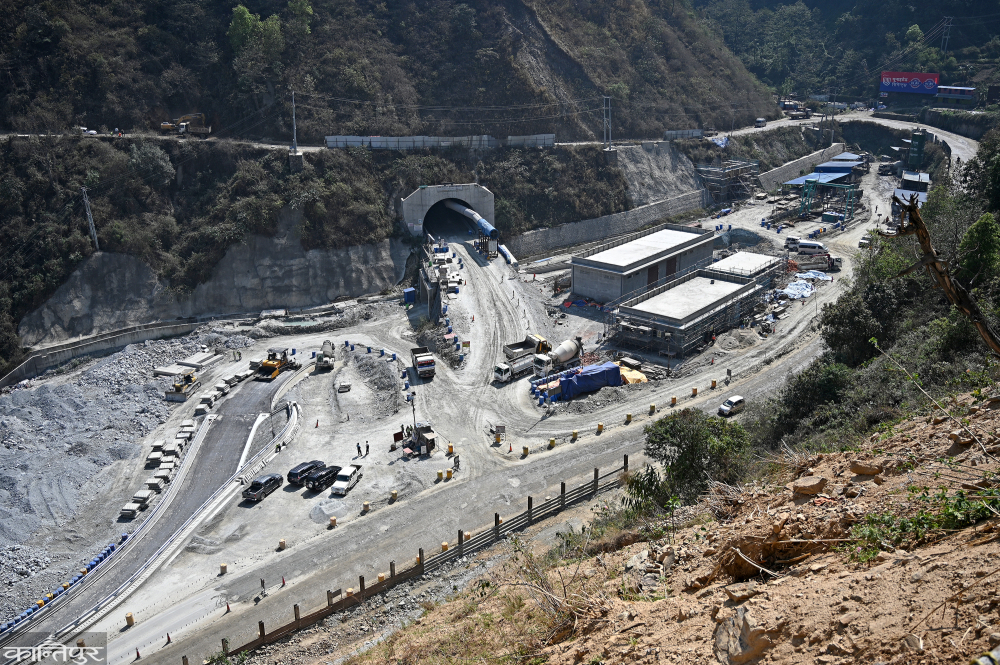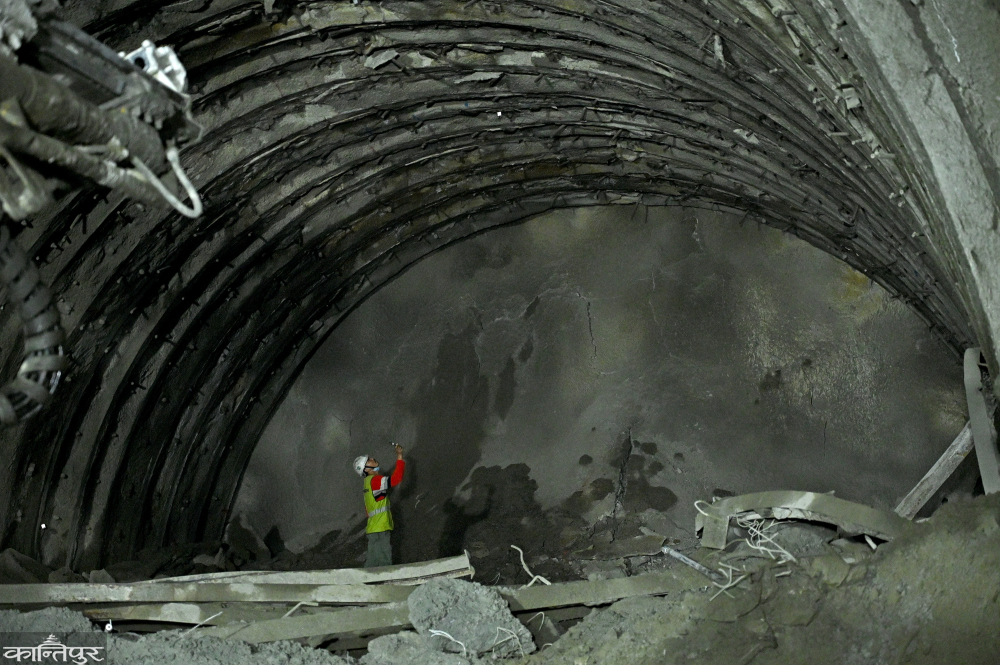Nagadhunga-Sisne river tunnel will break through on Monday
We use Google Cloud Translation Services. Google requires we provide the following disclaimer relating to use of this service:
This service may contain translations powered by Google. Google disclaims all warranties related to the translations, expressed or implied, including any warranties of accuracy, reliability, and any implied warranties of merchantability, fitness for a particular purpose, and noninfringement.


After 53 months of construction, Nagadhunga-Sisne river tunnel will be 'break through' on Monday. Now two meters of tunnel is left to be dug, which will be completed on the day of 'break through'. The rest will be dug up and 'break through' using explosives. According to the project, it will take one more year to operate vehicles through the tunnel.


After the tunnel is operational, the Sisne river of Dhading will be reached within three minutes from Thankot in Kathmandu. Govind Dumru, deputy project director of the Nagadhunga-Sisne river tunnel construction project, said that if there is no problem, the tunnel will be "break through" on Monday. According to the project, the Sisne River, which reaches eight and a half km from Balambu towards Kathmandu, will reach 2.688 km through the tunnel.
Vijay Jaishi, head of the Development Assistance Implementation Division under the Road Department, said that preparations have been made to break through within the specified time. "If its 'break through' could be done in February, the finishing work would have started now," he said, "Now, as soon as the 'break through' is done, the finishing work will start."
The main tunnel is 2.688 km and the emergency tunnel is 2.557 km. The emergency tunnel has been 'break through' on July 22. Finishing is going on now. The main tunnel was scheduled to break through on February 23. When 14 meters were left to be dug, the locals put forward new/old demands including drinking water, irrigation and stopped the work towards Dhading and Kathmandu for a month. which could not proceed with the tunnel digging.
 In the Ministry of Physical Infrastructure and Transport, the construction started from Chait 6 after a nine-point agreement between the Ministry and the locals. According to the project, the tunnel is being worked on around the clock by making 8/8 hour shifts. The tunnel was constructed by adopting the 'Drill and Blast Method'. Seven gates leading from the main tunnel to the emergency tunnel have been constructed. Dumru, Deputy Project Director of the project, said that an emergency tunnel has been built to quickly exit the main tunnel in case of any future incident inside the tunnel.
In the Ministry of Physical Infrastructure and Transport, the construction started from Chait 6 after a nine-point agreement between the Ministry and the locals. According to the project, the tunnel is being worked on around the clock by making 8/8 hour shifts. The tunnel was constructed by adopting the 'Drill and Blast Method'. Seven gates leading from the main tunnel to the emergency tunnel have been constructed. Dumru, Deputy Project Director of the project, said that an emergency tunnel has been built to quickly exit the main tunnel in case of any future incident inside the tunnel.
After 'break through', there will be lighting, oxygen connection, road slope work inside the tunnel. On the other hand, construction of flyover towards Balambu is going on in full swing. The work of this section also came to a standstill when the locals obstructed it. Three bridges and six culverts have been constructed. The 2.307 km two-lane road from Balambu to Tutipakha, where the tunnel enters, is black. A 565 meter access road will be constructed towards Sisne river in Dhading. "The construction of flyover and the road from Balambu to the tunnel is going on in full swing," said Dumru.
 He said that the main purpose of the construction of the tunnel is to manage the traffic jams in the Nagadhunga uphill. The main tunnel will have a two-lane road. Now, about 10,000 vehicles pass through Nagdhunga, big and small, every day. But vehicles carrying petroleum products, motorcycles and overloaded vehicles will not be allowed to use the tunnel. The tunnel will be monitored by CCTV cameras. For that, a technician will stay in Kathmandu. Although there is a discussion about charging toll for driving vehicles in the tunnel, no decision has been taken yet. The construction of the tunnel is being done by the Japanese company Hazma Endo Corporation.
He said that the main purpose of the construction of the tunnel is to manage the traffic jams in the Nagadhunga uphill. The main tunnel will have a two-lane road. Now, about 10,000 vehicles pass through Nagdhunga, big and small, every day. But vehicles carrying petroleum products, motorcycles and overloaded vehicles will not be allowed to use the tunnel. The tunnel will be monitored by CCTV cameras. For that, a technician will stay in Kathmandu. Although there is a discussion about charging toll for driving vehicles in the tunnel, no decision has been taken yet. The construction of the tunnel is being done by the Japanese company Hazma Endo Corporation.
This project, which is contracted for 22 billion rupees, has loan support of 16 and a half billion rupees from Japan. The Government of Nepal has invested 6 billion rupees in this. According to the initial agreement, the project period has ended in 080 Baisakh. Since the work is not completed within that time, the deadline has been extended to 081 Baisakh 13. According to the contract, the construction of the tunnel, which was started in October 2007, was to be completed within 42 months.

सहकारीको बचत अपचलनमा जोडिएका गृहमन्त्री रवि लामिछानेले प्रतिनिधिसभामा दिएको स्पष्टीकरणबारे तपाईंको के टिप्पणी छ ?







 २६.१२°C काठमाडौं
२६.१२°C काठमाडौं










